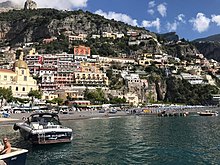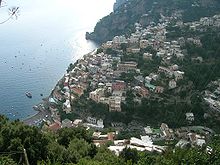Amalfi Coast
| UNESCO World Heritage Site | |
|---|---|
 Coastline from Ravello | |
| Official name | Costiera Amalfitana |
| Location | Campania, Italy |
| Criteria | Cultural: (ii), (iv), (v) |
| Reference | 830 |
| Inscription | 1997 (21st Session) |
| Area | 11,231 ha (43.36 sq mi) |
| Coordinates | 40°39′N 14°36′E / 40.650°N 14.600°E |
The Amalfi Coast (Italian: Costiera amalfitana or Costa d'Amalfi) is a stretch of coastline in southern Italy overlooking the Tyrrhenian Sea and the Gulf of Salerno. It is located south of the Sorrentine Peninsula and north of the Cilentan Coast.
Celebrated worldwide for its Mediterranean landscape and natural diversity, the Coast is named after the town of Amalfi, which makes up its main historical and political centre. It is a very popular jet set destination, and has been an attraction to upper-class Europeans since the 18th century, when it was a frequent stopover on their Grand Tours.
Attracting international tourists of all classes annually,[1] the Amalfi Coast was listed as a UNESCO World Heritage Site in 1997.[2] Atrani and Vietri sul Mare are counted among I Borghi più belli d'Italia ("The most beautiful villages of Italy").[3]
History[edit]
During the 10th–11th centuries, the Duchy of Amalfi existed on the territory of the Amalfi Coast, centred in the town of Amalfi. The Amalfi coast was later controlled by the Principality of Salerno until Amalfi was sacked by the Republic of Pisa in 1137.[4]
Geography[edit]


Like the rest of the region, the Amalfi Coast has a Mediterranean climate, featuring warm summers and mild winters. It is located on the relatively steep southern shore of the Sorrentine Peninsula, leaving little room for rural and agricultural development.[5] The only land route to the Amalfi Coast is the 40 kilometres (25 mi) long Amalfi Drive (Strada Statale 163) which runs along the coastline from the town of Vietri sul Mare in the east to Positano in the west. Thirteen municipalities are located on the Amalfi Coast, many of them centred on tourism.[6]
Municipalities[edit]
| Municipality | Frazioni | Attractions |
|---|---|---|
| Vietri sul Mare | Albori, Benincasa, Dragonea,[a] Molina, Raito | Church of Saint John Baptist |
| Cetara | Fuenti | Tower of Cetara |
| Maiori | Erchie, Ponteprimario, San Pietro, Santa Maria delle Grazie, Vecite | Collegiata di Santa Maria, Castle of San Nicola de Thoro-Plano (closed until further notice), Santa Maria de Olearia |
| Tramonti | Campinola, Capitignano, Cesarano, Corsano, Figlino, Gete, Novella, Paterno Sant'Arcangelo, Paterno Sant'Elia, Pietre, Polvica,[b] Ponte, Pucara | Conservatory of Pucara, Rupestrian Church in Gete |
| Minori | Montecita, Torre | Church of Santa Trofimena and the ancient Roman villa |
| Ravello | Casa Bianca, Castiglione, Marmorata, Sambuco, Torello | Villa Cimbrone, Villa Rufolo, San Giovanni del Toro, and the Duomo (Cathedral) |
| Scala | Campidoglio, Minuta, Pontone | Scala Cathedral |
| Atrani | none | Churches of San Salvatore del Birecto and Santa Maria Maddalena |
| Amalfi | Lone, Pastena, Pogerola, Tovere, Vettica Minore | Amalfi Cathedral, and its cloister (Italian: Chiostro del Paradiso) |
| Conca dei Marini | none | Main church of Saint John Baptist and the Emerald Grotto |
| Furore | Fiordo di Furore, Marina di Praia[c] | Fjord of Furore |
| Praiano | Vettica Maggiore | Churches of San Luca and San Gennaro and Saint John Baptist |
| Positano | Montepertuso, Nocelle | Church of Santa Maria Assunta |
Economy[edit]

The Amalfi Coast is known for its production of limoncello liqueur, made from lemon (known as sfusato amalfitano in Italian) grown in terraced gardens along the entire coastline between February and October.[7] Another typical liqueur, by far less known than limoncello, is Concerto (literally it means "concert"), a dark-colored rosolio with pronounced spicy notes typically produced in Tramonti, whose name derives precisely from the harmony of herbs that compose it. Amalfi is also a known maker of a hand-made thick paper called bambagina,[8] symbolic of Italy’s ancient traditional technique for paper production and historically used for private writings, legal acts, and revenue stamps. [9] Other renowned local products are a particular kind of anchovy (local Italian: alici) from Cetara, and the colourful handmade ceramics from Vietri.[10]
Transport[edit]
Buses and ferries run along the Amalfi Coast,[11] as well as boat excursions from Positano and Amalfi.
Airport[edit]

The Salerno Costa d'Amalfi Airport is the nearest. However, the most used airport to reach the area from abroad is Naples International Airport (Napoli-Capodichino).
In popular culture[edit]


The natural beauty and picturesque landscapes of the Amalfi Coast have made it one of the most popular destinations of the world's jet set, earning it the nickname of "Divine Coast" (Divina costiera).[citation needed]
The rulers of Amalfi are the central figures in John Webster's Jacobean tragedy The Duchess of Malfi. The Dutch artist M.C. Escher produced a number of artworks of the Amalfi coast,[12] and Spike Milligan describes his time in Amalfi during a period of leave in the fourth part of his war memoirs, Mussolini: His Part in My Downfall.[13]
The Amalfi Coast was used for scenes of Federico Fellini's 1972 film Roma and for the 2017 American superhero film Wonder Woman, where it was depicted as the Amazon island of Themyscira.[14]
The Amalfi Coast serves as a setting for fictional racetracks in the Forza Motorsport 3,[15] Forza Motorsport 4 and Gran Turismo 4. It also plays host to the fictional town of Sapienza in Hitman.
The city of Positano is featured in John Steinbeck's 1953 short story Positano.[16] The city is also featured in Under the Tuscan Sun, Christopher Nolan's Tenet and the Kath and Kim movie Kath & Kimderella.[17]
See also[edit]
- Cilentan Coast, located on the Gulf of Salerno's southern shore
- Amalfi
Notes[edit]
References[edit]
- ^ "Bay of Naples & Amalfi Coast History". Unique Costiera. Archived from the original on 31 October 2011. Retrieved 28 June 2011.
- ^ "Costiera Amalfitana". UNESCO World Heritage Centre. Retrieved 14 September 2015.
- ^ "Campania" (in Italian). Retrieved 1 August 2023.
- ^ Matthews, Jeff. "Naples". Around Naples Encyclopedia. University of Maryland University College. Archived from the original on 15 July 2011. Retrieved 14 September 2015.
- ^ "Amalfi Geography". Authentic Italy. Archived from the original on 4 July 2008. Retrieved 14 September 2015.
- ^ "Amalfi People and Culture". Authentic Italy. Archived from the original on 5 August 2014. Retrieved 14 September 2015.
- ^ "National cultivars". Limmi. Archived from the original on 21 July 2011. Retrieved 30 June 2011.
- ^ "The Amalfi Coast Paper Museum". Retrieved 26 January 2012.
- ^ Insolitaitalia, Redazione (20 September 2016). "History of the Amalfi Paper and its Museum". Insolita Italia. Retrieved 26 October 2021.
- ^ Pasquale, Maria (7 June 2017). "Vietri sul Mare: The undiscovered Amalfi Coast". CNN. Retrieved 14 March 2023.
- ^ "Amalfi coast bus & ferries: Timetables". Theamalficoast.net. Retrieved 14 September 2015.
- ^ "Atrani, Coast of Amalfi". mcescher.com. 1931.
- ^ see Penguin paperback edition, pp 220 and forwards
- ^ "Here Are the Magical Places the Cast of Wonder Woman Stayed in Italy". cosmopolitan.com. 1 June 2017. Retrieved 19 March 2018.
- ^ "Forza 3's Ferrari Collection, Amalfi Coast Track Pictured". ShackNews. Retrieved 30 June 2011.
- ^ "Positano by John Steinbeck". FortuneCity. May 1953. Archived from the original on 8 June 2011. Retrieved 28 June 2011.
- ^ "Kath and Kimderella". Time Out Worldwide. Retrieved 20 October 2020.
External links[edit]
- Province of Salerno, Campania, Italy at Curlie
- Amalfi Coast Archived 2018-02-09 at the Wayback Machine at ENIT – Italian National Tourist Board



